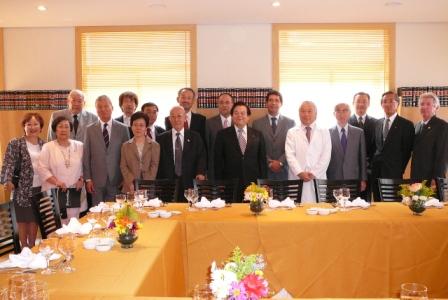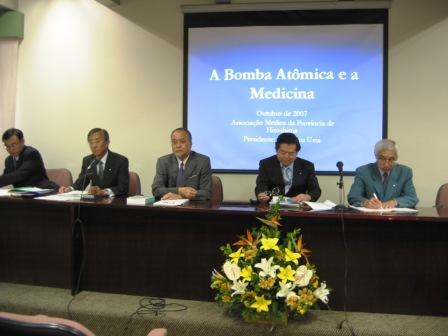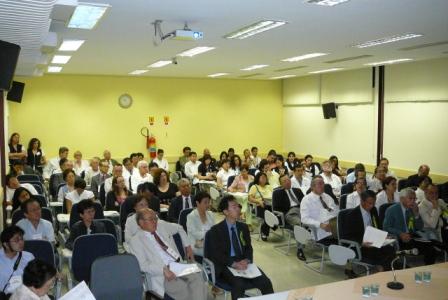Over the Years
Home > Over the Years > > Dispatched HICARE President to Brazil
Dispatched HICARE President to Brazil
We dispatched the President and other members of HICARE to Brazil to improve the environment so that aging A-bomb survivors residing in Brazil could receive on-site medical care with ease. Moreover, we aimed to provide training regarding the medical care of A-bomb survivors to local medical professionals in the Federative Republic of Brazil, in cooperation with the Hiroshima Prefectural Medical Association and Hiroshima Prefecture.
Period of Dispatch:
October 8 to October 19, 2007
Members:
| Name | Title |
|---|---|
| Shizuteru Usui | President, Hiroshima Prefectural Medical Association |
| Hiroo Dohy | President, HICARE President, Hiroshima Red Cross Hospital & Atomic-Bomb Survivors Hospital |
| Katsuhide Ito | Executive Secretary, HICARE Professor, Hiroshima University |
| Makoto Matsumura | Executive Director, Hiroshima Prefectural Medical Association |
| Kuniaki Nomura | Director, Health and Welfare Bureau, Hiroshima Prefectural Government |
| Takeshi Yahata | HICARE Secretariat |
| Toru Funaoka | HICARE Secretariat |
On-Site Schedule:
Date | City | Content |
|---|---|---|
October 9 (Tue.) | Sao Paulo | Visit the war memorial at the settlement of Japanese immigrants Visit the Medical Association of the State of Sao Paulo, the Japanese Consulate General in Sao Paulo, Hospital A.C. Camargo and Hiroshima Ken-Jin Kai in Brazil |
October 10 (Wed.) | Sao Paulo | Deliver a lecture to physicians at Hospital A.C. Camargo (President Dohy) (41 participants) Provide training at Hospital Nipo-Brasileiro (80 participants) Hold health lectures (Dr. Matsumura; in the morning: Senior Citizens’ Club; in the afternoon: Nipo-Brasileiro Cultural Institution) |
October 11 (Thu.) | Sao Paulo | Provide training at Hospital Santa Cruz (120 participants) |
October 12 (Fri.) | Sao Paulo | Hold a health lecture at the Association for A-bomb Survivors in Brazil (Dr. Matsumura) Exchange opinions with the Association for A-bomb Survivors in Brazil (prefectural administration of Hiroshima) Hold health consultation (organized by HMA; 20 consulters) |
October 13 and 14 | Move, etc. | Moving and preparation |
October 15 (Mon.) | Curitiba | Visit President of the Brazilian Red Cross of the State of Parana, Sugisawa Hospital and Erasto Gaertner Cancer Hospital Hold health consultation (organized by HMA; 4 consulters) Provide training at the Medical Association Hall of the State of Parana (105 participants) |
* Reports on the transfer between Hiroshima and Brazil and domestic events after returning to Japan, such as reporting to the Ministry of Health, Labour and Welfare, are omitted.

Visiting the Medical Association of the State of Sao Paulo (Paulista Medical Association)

Training program at Hospital Nipo-Brasileiro (instructors)

Training program at Hospital Santa Cruz: Scene of training
Comments:
Hiroo Dohy, President of HICARE (Training at the Cancer Hospital in Sao Paulo)
At 6:20 on October 10, Mr. Onishi, President of the Hiroshima Ken-Jin Kai, came to the Matsubara Hotel to meet us. In spite of a small misunderstanding, we were able to arrive at the venue at 6:50. I felt lonely at first because there were only three of us: two persons who were in charge of the seminar in the front and only myself following them. However, people came in one after another from around 7:00, culminating in the eventual participation of 41 persons. The seminar was so successful that we had to prepare additional chairs.
A lecture presentation was given at the Department of Radiology of the Cancer Hospital, which was attended by Professor Salvajoli of the Department of Radiology and an elderly pathologist.
The lecture presentation started at around 7:07 presided by Dr. Torloni. After I was introduced, I delivered a lecture in English for approximately 40 minutes. I talked about a variety of topics, ranging from the Hiroshima Red Cross Hospital before and immediately after the A-bombing, Ms. Sadako Sasaki (a Japanese girl who died from the effects of the A-bomb and today is a symbol of innocent victims of war), the Children's Peace Monument, keloids caused by radiation exposure and 25 young women who had suffered from keloid scars due to the A-bomb and left for the U.S. to receive treatment to the Life Span Study (LSS) at the former Atomic Bomb Casualty Commission (ABCC) and the Radiation Effects Research Foundation, identification of the causes of cancer and increases in the estimated incidence of cancer. As a theme that we should pursue, I placed emphasis on the importance of cancer study and myelodysplastic syndrome (MDS) because 91% of young A-bomb survivors are still alive.
After my lecture, I was asked two questions by the pathologist. One was about the importance of teeth lost by A-bomb survivors. I told him that radiation doses could be measured from the enamel of the teeth. The other question was regarding the difficulty and accuracy of cohort studies. I explained that we had been able to increase the accuracy of the study to 98% by tracing even the individual items of data concerning a patient's death.
Taken to a separate room by Dr. Torloni and Professor Salvajoli after the lecture presentation, I enjoyed snacks with them. Seeing other people coming to join us, I understood that it was common in Brazil to have breakfast after a lecture presentation held in the early morning. Then I headed for the Hospital Nipo-Brasileiro in Mr. Kikuchi's car.
Katsuhide Ito, Executive Secretary of HICARE
This was the first time for me to visit Brazil. Although I had heard that Brazil was far away from Japan, I realized that this was true after a 40-hour journey from my home to a hotel in Sao Paulo. After paying a courtesy call on the Medical Association of the State of Sao Paulo and the Japanese Consulate General, we visited Hospital A.C. Camargo. This hospital is said to be one of the largest cancer hospitals in South America, with approximately 10,000 outpatients visiting the hospital per day, attracting residents from throughout Brazil. I fully appreciated the fact that for 10,000 patients to receive treatment here it was necessary for each department to have nearly 20 examination rooms. Although I did not visit the Department of Radiation because it was located in a separate building, I heard that electron beam computed tomography (EBCT) was used for computerized tomography (CT). EBCT is a CT specifically designed for circulatory organs rather than for the trunk of the body. At the Hiroshima University, EBCT used to be utilized but has been currently replaced by a more sophisticated multi detector CT (64 rows).
From the 10th, the following day, Mr. Hiroo Dohy, President of HICARE (Vice Leader) delivered a lecture on solid cancer in A-bomb survivors to residents of Hospital A.C. Camargo in the early morning and then joined us at Hospital Nipo-Brasileiro. After a lecture presentation, we were taken around the Department of Radiation by Ms. Rosa Shizuka Okubo, who had received training at the Department of Radiation Oncology of Hiroshima University for three months. Four diagnostic radiologists were engaged in reading old-type CT scans, which were to be replaced by new ones, and newly-introduced MRI scans. They worked making the best use of the performance of these devices.
Although there were four radiologists, not all of them provided treatment there every day as a full-time physician. Most of them worked at several facilities, for example, visiting a certain hospital on Monday and another hospital on Tuesday. To grasp the number of physicians actually working in the whole hospital, it seems more appropriate to ask how many physicians come to the hospital on the day, rather than how many physicians belong to the hospital. Both Hospital Nipo-Brasileiro and Hospital Santa Cruz have only 200 beds each for the hospitalization of their outpatients.
A health lecture given by Dr. Matsumura of HMA, who conducted separate activities from us, appeared prominently in Sao Paulo newspapers the following day. It would not be an exaggeration to say that "December 10" was the day of Dr. Matsumura.
On the 11th, a lecture presentation was held at Hospital Santa Cruz. Since not only Dr. Matsumura but also the purposes of our visit to Brazil told by Leader Usui appeared in the morning newspapers, more than 120 participants attended the lecture presentation.
On the 12th, Dr. Matsumura delivered a lecture titled "The Importance of Strolling for Good Health" to A-bomb survivors living in Sao Paulo and neighboring areas. After that, we provided health consultations, in which an A-bomb survivor told us that he had felt chest pain for a few days. He was diagnosed with cardiac infarction and taken to a hospital. The cost of treatment was too expensive for him to pay unless he bought insurance from a private insurance company. We heard that approximately half of the 160 A-bomb survivors residing in Brazil had not bought insurance from private insurance companies. The future challenge is how we will support uninsured A-bomb survivors.
On the 15th, we visited Erasto Gaertner Cancer Hospital, which provided treatment under a free medical insurance system. Guided by Dr. Dino Kusakawa, an orthopedist of Japanese descent, Vice Leader Dohy and I visited there with Ms Sato as an interpreter. Although the hospital possessed four linear accelerators (LINACs) as radiotherapy equipment, three of them were purchased 20 years before and the remaining one, a machine manufactured by Varian and introduced a few years before, was only used for treatment. They explained that they used the Remote After Loading System (RALS), which was purchased one year before, mainly to treat the prostate gland, and that the number of patients treated with RALS would shortly reach 1,000. At the hospital, patients with skin cancer were the most common, comprising almost 20% of the total patients, followed by 17% of patients with uterine cancer and 14% of patients with breast cancer. Since medical expenses reimbursed by the national government were only one fifth of the normal level, they could barely afford to replace equipment. As a matter of course, salaries for physicians and other medical professionals were low. This forced them to work at several hospitals. Hospital doctors in Brazil were overworked, just like their counterparts in Japan.
We provided a training program at the Medical Association Hall of the State of Parana in the evening, which was also attended by students.




